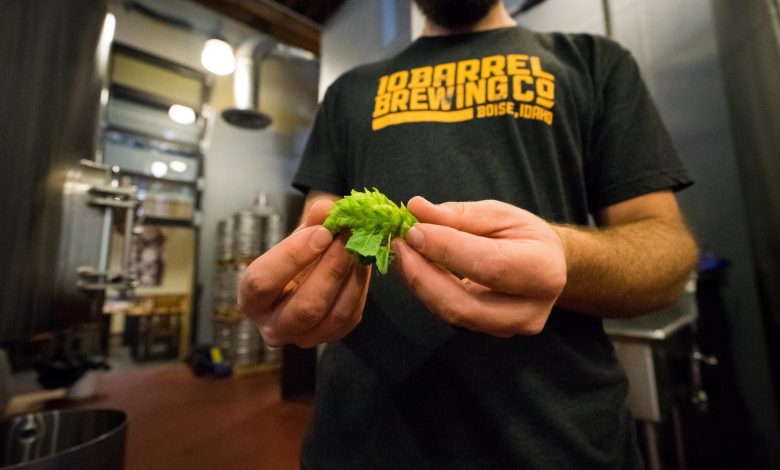Dry Hopping Techniques

Hops form one of the primary ingredients used in beer-making. They’re responsible for the taste of your beer, including its bitterness, aroma, and flavor. The time in which they’re added during the brewing process determines what your beer will taste like eventually.
The alpha-acids in hops are responsible for the bitterness in beer. On the other hand, the volatile oil present in this ingredient produces the flavor and aroma in your brew.
The Meaning of Dry Hopping
The British brewers were the first to make use of the phrase dry hopping many centuries ago before it became a widespread phenomenon. They referred to this term when they imply that they included hops to the keg before transporting it to the buyers. The British hops producers developed half an ounce hops plugs as a natural means of adding entire hops to a cask or keg.
When the wort is cool, brewers refer to the addition of hop to the beer as dry hopping. This process may be executed in the primary or secondary fermenter, or by putting hops directly into a keg.
Advantages of Dry Hopping
One distinct advantage is that essential oils in the hops are not heated away. This gives brewers an advantage when dry hopping; they get their desired flavors or aromas in the beer produced. This instills floral aroma into your brew and a strong flavor yearned for in hoppy beer styles like the Pale ales and India Pale Ales (IPAs). Commercial beers like Bell’s Two Hearted Ale, Avery India Pale Ale, and Squatters IPA were all dry-hopped.
Kindly note that dry hopping doesn’t produce bitterness in beers; the bitter taste is achievable in beers during boiling when the alpha-acids in the hops are transformed into other acids like iso-alpha acids. Furthermore, the bitter taste is retainable when you include the hops that impart this flavor to the boil.
Disadvantages of Dry Hopping
The absence of boiling is a potential disadvantage of this brewing process, given that the hops aren’t sanitized since they aren’t boiled. This deficiency turns off many beer makers, particularly those who are yet to try dry hopping.
However, the truth remains that hops don’t create a supporting atmosphere for many kinds of bacteria. Also, the inclusion of the hops to the primary fermenter following the fermentation process makes it difficult for bacteria to rival the active yeast added to the wort.
More so, the addition of the hops to the secondary fermenter can hinder bacterial growth due to the declined pH of the beer and the percentage of alcohol. So one can say that the introduction of bacteria resulting from dry hopping rarely happens and shouldn’t deter a brewer from dry hopping.
The other disadvantage of the process may be that consumers don’t appreciate the outcome of dry hopping. They believe it gives the beer a slick taste. Dry hopping certainly gives a varying kind of aroma and flavor much different from the conventional technique of including hops to the boiling wort. However, if you’ve been gulping some pints of dry-hopped beers in the past, you’ll most likely not have a problem with brewing your beers using your preferred dry hopping technique. So go ahead and try it.

Decide the Hop to Use
So you’ve decided to dry hop; it’s time to pick the type of hop you’ll like to use. Cascade, Fuggle, Tettnanger, Crystal, Willamette, Saaz, East Kent Golding, and Hallertau are some of the hop varieties used for dry hopping. Usually, you’d want to pick the hop that promises to give an aroma or flavor. Meanwhile, it’s not surprising to find hops with a low alpha-acid percentage varying between six percent or below.
Undisputably, one of the advantages of brewing your beer is that you’re the boss. Hence, it’s possible to use the different types of high alpha-acid like Chinook and Centennial to dry hop. It’d be best if you carried out your experiments to figure out your preference. Overall, if you prefer the outcomes of utilizing a specific type of hop within the shortest time of the boil, then you may prefer the result of dry hopping with that particular hop.
Where to Carry Out the Process
Dry Hopping in Primary Fermenter
It’s viable to dry hop in the primary fermenter. In fact, some brewers prefer it; however, others advise against this method. This disapproval is as a result of the bubbling carbon dioxide and the uproaring of the wort at the initial fermentation, which is known to lessen the aromatic smell in the beer in the same manner as boiling.
We advise you to increase your hops during the initial fermentation more than you would in a keg or glass carboy during secondary fermentation.
Dry Hopping in Secondary Fermenter
Dry Hopping in Glass Carboy
Many reasons bolster the belief that a glass carboy is the most advisable container to dry hop. For one, the fermentation of the beer must have taken place, and thus, as earlier mentioned, the declined pH and alcohol presence repels any bacteria present in the unsanitized hops. Additionally, the work of the strong carbon dioxide of the primary fermenter must have come to an end; thus, the hops aroma won’t vanish from the beer.
Nevertheless, there’s a downside to using a glass carboy to dry hop. Trying to get the hops into and out of the slim opening of this equipment can be off-putting, especially if you’re a brewer who fancies the ease and advantage that comes with using a hop steeping bag.
Therefore, we advise you forfeit using a carboy and instead utilize a bucket with a considerable opening. Subsequently, you can segregate the hops from the beer when transferring the brew to your keg or bottling bucket.
Dry Hopping in Keg
The keg is the last medium where dry hopping can take place. When using this medium, package the hops in a cheesecloth bag or muslin. Otherwise, the hops may go into the vessel. The downside of using this medium is the ample time the hop remains in the drink. Some beer makers believe that when the hops come in contact with the beer beyond a couple of weeks, the drink may acquire a “slick” flavor.
Dry Hopping With the Different Hops
Dry hopping with plugs is no surprise because they were created for that purpose. They aren’t difficult to measure mainly because each plugs measure as half an ounce. Moreover, you encounter zero difficulties when fixing it into a hop steeping bag, and similarly when passing through the carboy opening, especially when cut into two.
Loose hops must be weighed; nevertheless, they quickly go into a carboy. Pellet hops need weighing too, and they’re likely the easiest to enter a glass carboy. Pellet can comfortably get into a bag, but you’ll need a fine mesh hop bag to hold the dissolved particles.
Pellets can result in a sudden outburst of beer head that’ll have you grabbing for a cleaner. This is a result of the pellets disintegrating, thus creating several starting points for the gas, carbon dioxide, in the beer to bind itself and leave the solution. So it takes your full attention to use pellet to dry hop.
Well-soaked pellet hops effortlessly sink in a solution. Contrarily, loose and plug hops will stay afloat in the solution. However, with due diligence, racking the beer from either pellets, loose hops, or plugs won’t be difficult.
Given that pellet hops are better processed than the other forms of hops, it’s no surprise that essential oils may be lost. We advise you to add more pellets when using them to dry hop.

Decide Whether to Bag Your Hops or Not
Are you wondering whether to use a hop steeping bag or not? Putting your hops in a bag makes it a breeze to collect them when the time is right. You should know that hops enlarge when moist. Thus, a bag of hops which successfully passed through a glass carboy may prove difficult to retrieve when well soaked.
Another downside to bagging your hops may be that the bag lessens the hops’ contact with the beer. You can bridge this gap if you use between ten to 15 percent more when steeping your hops. Another thing is, the hops may not be carriers of bacteria; however, that isn’t the case for the bag. We advise you to boil the bag; this way, you’ll be sanitizing it before bagging your hops.
Dry Hopping Duration
Dry hopping is an excellent means to infuse the aroma into your beer, but you must grasp the duration for dry hopping so you don’t mess up your brew day.
When you add hops during secondary fermentation, the aroma comes alive within a day and becomes even better within two to three days. Afterward, you may still get an improved aroma but not as rapidly as before.
Besides, don’t be surprised to find homebrewers keeping hops in their fermenter for the whole secondary fermentation. However, doing so beyond a few weeks may cause a “grassy” flavor or other unwanted flavors.
After two to three weeks, endeavor to rack your beer off your hops; otherwise, you’ll end up with bad flavors. We advise you stick to 48 to 72 hours after which you can package your beer.
Overall, dry hopping involves inundating your hops in your fermented beer. How you achieve this is all up to you.



